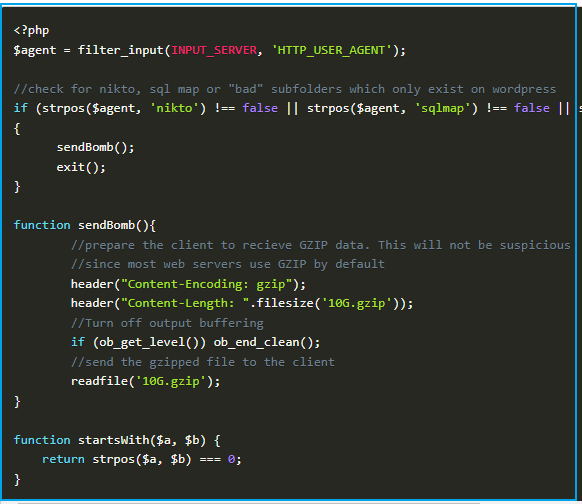Gzip 炸彈英文名為 Gzip bomb,是一種古老的被動防御手段。它的原理是當爬蟲訪問服務器網頁資源時摻入一些高壓縮比的壓縮文件。如果爬蟲自帶解壓縮功能(比如 Python requests 庫)就會觸發壓縮炸彈,直接導致爬蟲的客戶端內存被撐爆。
以下是制作 Gzip 炸彈的命令:
dd if=/dev/zero bs=1M count=10240 | gzip > 10G.gzip
PHP 版的服務端 Gzip bomb 例子;

PHP 代碼來源鏈接:
《How to defend your website with ZIP bombs- the good old methods still work today》Posted on 2017-07-05
https://blog.haschek.at/2017/how-to-defend-your-website-with-zip-bombs.html
許多爬蟲會使用 requests 庫爬取網頁資源,在使用 requests 庫時如何避免被 gzip 炸彈攻擊?
為了避免被 Gzip 炸彈攻擊,在使用Python的 requests 庫時,可以設置stream 參數為 True。這將使得響應內容不會被自動解壓縮,而是在使用時才進行解壓縮,從而可以限制解壓縮的大小。
示例代碼:
import requests
url = 'http://example.com/some_large_file.gz'
# 設置 stream=True 來避免自動解壓縮response = requests.get(url, stream=True)
# 手動解壓縮并限制解壓縮的大小max_size = 1024 * 1024 * 10 # 限制解壓縮的大小為10 MBdecompressed_data = bytearray()for chunk in response.iter_content(chunk_size=1024): decompressed_data.extend(chunk) if len(decompressed_data) > max_size: # 如果解壓縮后的數據大小超過了限制,則拋出異常 raise Exception("Response too large, possible gzip bomb attack.")
這樣做可以確保請求不會在解壓縮時耗盡系統資源,從而防止Gzip炸彈攻擊。
參考:
《How to defend your website with ZIP bombs》https://blog.haschek.at/2017/how-to-defend-your-website-with-zip-bombs.html
《github flask bomb》https://github.com/khast3x/flaskbomb?tab=readme-ov-file
《Demo - 20G Payloads>https://asciinema.org/a/141464
《github gzip-bomb topics》https://github.com/topics/gzip-bomb
《幾行代碼直接炸了爬蟲服務器》 作者kingnamehttps://mp.weixin.qq.com/s/Lzo6Pm09XsOqPkz3O91Mgg
《哈哈,有人爬我網站,我把他教育了一頓!》 程序員魚皮https://mp.weixin.qq.com/s/OX4fwC9Oe3R6cHYoyXpskA
該文章在 2024/3/9 16:03:49 編輯過